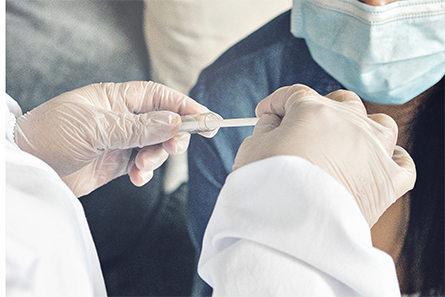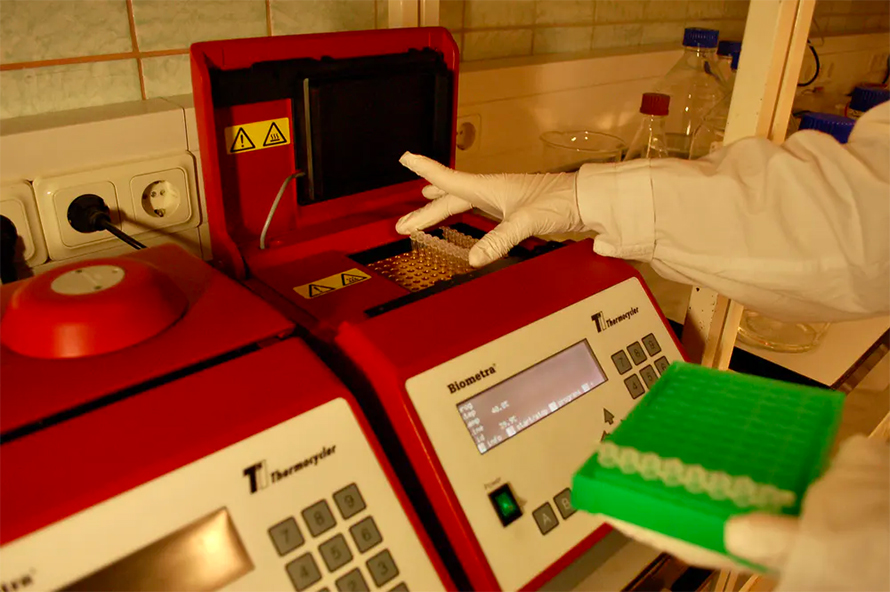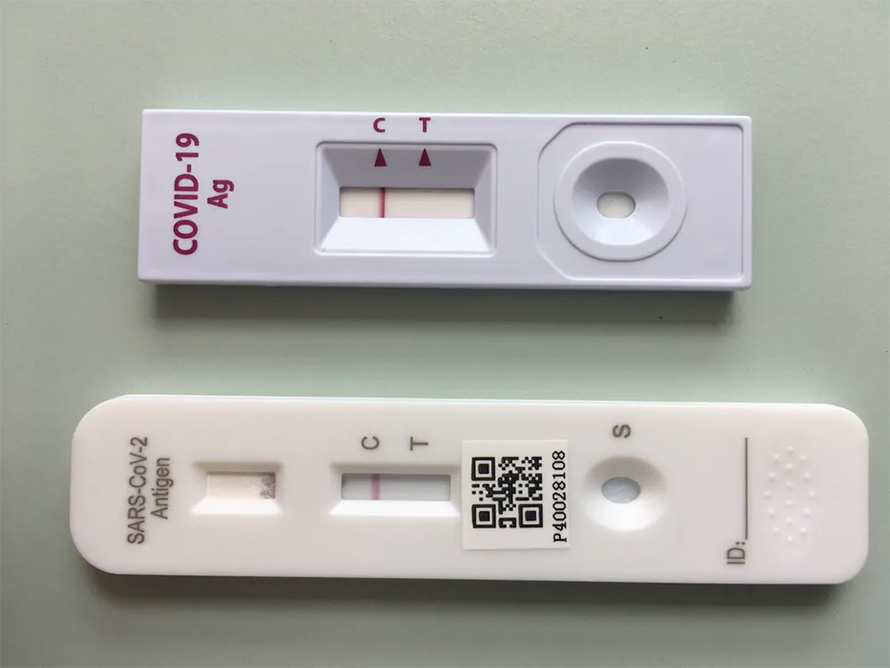What’s the difference between a PCR and antigen COVID-19 test?
At this point in the pandemic, you or someone you know has probably received at least one COVID-19 test. But do you know which kind of test you got and the strengths and weaknesses of these different tests?

I’m a molecular biologist, and since April 2020 I’ve been part of a team working on a National Institutes of Health-funded program called RADx that is helping innovators develop rapid tests to detect when a person is infected with SARS-CoV-2, the virus that causes COVID-19.
Two major types of tests are used to diagnose infection with SARS-CoV-2: molecular tests — better known as PCR tests — and antigen tests. Each detects a different part of the virus, and how it works influences the test’s speed and relative accuracy. So what are the differences between these types of tests?
Looking for genetic evidence
The first step for either kind of test is to get a sample from the patient. This can be a nasal swab or a bit of saliva.
For PCR tests, the next step is amplification of genetic material so that even a small amount of coronavirus genes in the patient’s sample can be detected. This is done using a technique called a polymerase chain reaction. A health care worker takes the sample and treats it with an enzyme that converts RNA into double-stranded DNA. Then, the DNA is mixed with a solution containing an enzyme called a polymerase and heated, causing the DNA to separate into two single-stranded DNA pieces. The temperature is lowered, and polymerase, with the help of a small piece of guide DNA called a primer, binds to the single-stranded DNA and copies it. The primers ensure that only coronavirus DNA is amplified. You’ve now created two copies of coronavirus DNA from the original one piece of RNA.

Laboratory machines repeat these heating and cooling cycles 30 to 40 times, doubling the DNA until there are a billion copies of the original piece. The amplified sequence contains fluorescent dye that is read by a machine.
The amplifying property of PCR allows the test to successfully detect even the smallest amount of coronavirus genetic material in a sample. This makes it a highly sensitive and accurate test. With accuracy that approaches 100%, it is the gold standard for diagnosing SARS–CoV–2.
However, PCR tests have some weaknesses too. They require a skilled laboratory technician and special equipment to run them, and the amplification process can take an hour or more from start to finish. Usually only large, centralized testing facilities – like hospital labs – can conduct many PCR tests at a time. Between sample collection, transportation, amplification, detection and reporting, it can take from 12 hours to five days for a person to get results back. And finally, they aren’t cheap at $100 or more per test.
Antigen tests
Rapid, accurate tests are essential to contain a highly contagious virus like SARS-CoV-2. PCR tests are accurate but can take a long time to produce results. Antigen tests, the other major type of coronavirus test, while much faster, are less accurate.
Antigens are substances that cause the body to produce an immune response – they trigger the generation of antibodies. These tests use lab-made antibodies to search for antigens from the SARS-CoV-2 virus.
To run an antigen test, you first treat a sample with a liquid containing salt and soap that breaks apart cells and other particles. Then you apply this liquid to a test strip that has antibodies specific to SARS-CoV-2 painted on it in a thin line.
Just like antibodies in your body, the ones on the test strip will bind to any antigen in the sample. If the antibodies bind to coronavirus antigens, a colored line appears on the test strip indicating the presence of SARS-CoV-2.
Antigen tests have a number of strengths. First, they are so easy to use that people with no special training can perform them and interpret the results – even at home. They also produce results quickly, typically in less than 15 minutes. Another benefit is that these tests can be relatively inexpensive at around $10-$15 per test.
Antigen tests do have some drawbacks. Depending on the situation, they can be less accurate than PCR tests. When a person is symptomatic or has a lot of virus in their system, antigen tests are very accurate. However, unlike molecular PCR tests, antigen tests don’t amplify the thing they are looking for. This means there needs to be enough viral antigen in the sample for the antibodies on the test strip to generate a signal. When a person is in the early stages of infection, not a lot of virus is in the nose and throat, from which the samples are taken. So, antigen tests can miss early cases of COVID-19. It’s also during this stage that a person has no symptoms, so they are more likely to be unaware they’re infected.

More tests, better knowledge
A few antigen tests are already available over the counter, and on Oct. 4, the Food and Drug Administration granted emergency use authorization to another at-home antigen test. The U.S. government is also pushing to make these tests more available to the public.
At RADx, the project I am a part of, we are currently conducting clinical studies to get a better understanding of how antigen tests perform at various stages of infection. The more data scientists have on how accuracy changes over time, the more effectively these tests can be used.
Understanding the strengths and limitations of both PCR and antigen tests, and when to use them, can help to bring the COVID-19 pandemic under control. So the next time you get a COVID-19 test, choose the one that is right for you.![]()
This article is republished from The Conversation under a Creative Commons license. Read the original article.
Enjoy reading ASBMB Today?
Become a member to receive the print edition four times a year and the digital edition monthly.
Learn moreGet the latest from ASBMB Today
Enter your email address, and we’ll send you a weekly email with recent articles, interviews and more.
Latest in Science
Science highlights or most popular articles

Targeting Toxoplasma parasites and their protein accomplices
Researchers identify that a Toxoplasma gondii enzyme drives parasite's survival. Read more about this recent study from the Journal of Lipid Research.

Scavenger protein receptor aids the transport of lipoproteins
Scientists elucidated how two major splice variants of scavenger receptors affect cellular localization in endothelial cells. Read more about this recent study from the Journal of Lipid Research.

Fat cells are a culprit in osteoporosis
Scientists reveal that lipid transfer from bone marrow adipocytes to osteoblasts impairs bone formation by downregulating osteogenic proteins and inducing ferroptosis. Read more about this recent study from the Journal of Lipid Research.

Unraveling oncogenesis: What makes cancer tick?
Learn about the ASBMB 2025 symposium on oncogenic hubs: chromatin regulatory and transcriptional complexes in cancer.

Exploring lipid metabolism: A journey through time and innovation
Recent lipid metabolism research has unveiled critical insights into lipid–protein interactions, offering potential therapeutic targets for metabolic and neurodegenerative diseases. Check out the latest in lipid science at the ASBMB annual meeting.

Melissa Moore to speak at ASBMB 2025
Richard Silverman and Melissa Moore are the featured speakers at the ASBMB annual meeting to be held April 12-15 in Chicago.

